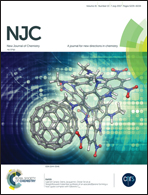Branched RCA coupled with a NESA-based fluorescence assay for ultrasensitive detection of miRNA†
Abstract
We report the development of a novel fluorescence biosensing strategy based on branched-rolling circle amplification (RCA) coupled with nicking endonuclease signal amplification (NESA) for the ultrasensitive and highly specific detection of miRNA. This biosensor relies on target miRNA-triggered quadratic RCA and endonuclease-assisted cyclic nicking of a molecular beacon (MB). The specific binding between target miRNA and hairpin probe 1 (HAP1) leads to a change in the conformation of HAP1, releasing an exposed DNA segment that can hybridize with circular probe 1 and subsequently induce a primary RCA reaction. The generated RCA product combines specifically to hairpin probe 2 (HAP2), resulting in unfolded HAP2 and liberating a new exposed DNA segment that can initiate quadratic RCA. Then MB hybridizes with the tandem repeated DNA segments produced by quadratic RCA, forming the specific nicking site of the nicking endonuclease. Therefore, the nicking endonuclease cleaves MB into two pieces, liberating a strong fluorescence signal. Meanwhile, the quadratic RCA products initiate the next cycle of hybridization and cleavage, thereby acquiring a significantly increased fluorescence signal. Using the branched-RCA coupled with the NESA strategy, an ultrasensitive miRNA-155 assay method has been developed with a wide linear range from 5 aM to 500 fM and a low detection limit of 3.9 aM. This work is, to our knowledge, the first report that branched-RCA coupled with NESA has been used for the fluorescence assay of miRNA. The developed biosensing strategy might hold great potential for detecting miRNA and for early diagnosis in miRNA-related diseases.



 Please wait while we load your content...
Please wait while we load your content...